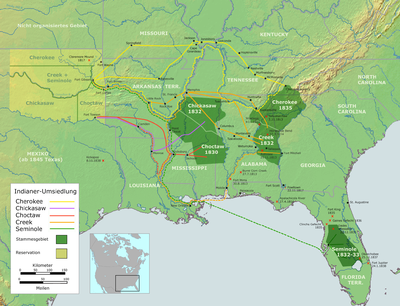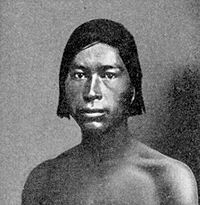Chickasaw
![]()
The title of this article is ambiguous. For other meanings, see Chickasaw (disambiguation).
The Chickasaw are a North American Indian people who originally settled along the Tennessee River in what are now the states of Mississippi, Alabama, and Tennessee, and are part of the Southeastern Woodlands cultural area of the United States. The name "Chickasaw" comes from "chikasha" and means either "rebel" or "coming from Chicsa".
The Chickasaw Nation in Oklahoma is the thirteenth largest federally recognized tribe in the United States with approximately 38,000 tribal members today. In addition, there are the Chaloklowa Chickasaw Indian People, who were officially recognized by the state of South Carolina as a Native American Indian group (not to be confused with state recognized tribe) in the summer of 2005.
They are closely related both linguistically and culturally to the Choctaw (Chahta), for both languages - the Chickasaw (Chikashshanompa') and Choctaw (Chahta Anumpa) - form what is known as the West Maskoki of the Muskogee (Maskoki) language family.
By the 19th century, both - along with the Muskogee (Maskoki), Seminole, and Cherokee (Tsalagi) - were known as one of the Five Civilized Nations because they had adopted a variety of cultural and technological "practices" from Europeans through assimilation and acculturation - often forced or undertaken for self-protection. However, this did not protect them any more than the other four peoples from being forcibly displaced on the Trail of Tears into the newly defined Indian Territory, now Oklahoma, during the Indian Removal Era under pressure from the U.S. Army.

Former Chickasaw tribal territory and first reservation (1838), Trail of Tears, and battles involving Native Americans in the southeastern United States between 1811 and 1847.
History
The origin of the Chickasaw is uncertain. When they were first described by Europeans, the Chickasaw lived in villages in what are now Mississippi and West Tennessee, with smaller numbers in South Carolina. They probably migrated to this area and may not have been descendants of the prehistoric Mississippian Indians.
The Chickasaw had a reputation for being brave and strong warriors. Their warlike culture can be compared to that of the ancient Spartans. The first contact of Europeans with the Chickasaw was in 1540, when the Spanish explorer Hernando de Soto described them. After several misunderstandings, the Chickasaw attacked De Soto's expedition and the Spaniard moved on.
The Chickasaw began trading with the British after the colony of Carolina was established in 1670. Supplied with weapons by the British, the Chickasaw raided their enemies, the Choctaw, captured them, and sold them into slavery, a practice that only ended when the Choctaw in turn received weapons from the French. The Chickasaw often had battles against the French and Choctaw in the 18th century, such as the Battle of Ackia in May 1736, until France relinquished its territories in the region after the Seven Years' War.
The majority of the tribe was deported to Indian Territory during the Indian Removal of the 1830s (headquarters in present-day Ada, Oklahoma). Members of the South Carolina Chickasaw, also known as the Chaloklowa Chickasaw, organized a tribal government and were officially recognized by the state of South Carolina in the summer of 2005 (headquarters in Indiantown (South Carolina)).
During the American Civil War, the Chickasaw Nation was allied with the Southerners and was the last Confederate community to surrender to U.S. forces.
The capital of the Chickasaw Nation was Tishomingo (Oklahoma) from 1855 to 1907. The third main building was used as the Johnston County Courthouse until recently when it was reclaimed by the Chickasaw Nation. The present main building was constructed of red granite in the Victorian Gothic style and is located in Ada.

A young Chickasaw warrior around 1830
Culture
The Chickasaw, like many indigenous peoples, had a dual organization and traditionally divided their villages as well as their entire society into two matrilineal moieties (hereditary lines) - the "Impsaktea" and the "Intcutwalipa" - each of which referred to a tribal mother and thus to common blood relations, so that the Chickasaw thus traced themselves separately to two (legendary) tribal mothers. Since marriages between "kin" were not allowed, marriages were not allowed within the two Moieties, but only between them (exogamy, to avoid kin marriage). Moreover, membership in the respective moiety was hereditary and unchangeable, thus one continued to belong to one's own moiety even after marriage.
"Pashofa," broken white dry corn cooked with pork, is a staple dish that is still eaten. Pigs are not part of the original fauna of the Americas; however, some specimens escaped from De Soto's expedition and became feral.
The suffix "-mingo" is used to indicate chieftaincy. For example, "Tishomingo" was the name of a famous Chickasaw chief. The town of Tishomingo (Mississippi) and Tishomingo County were named after him. Black Mingo Creek in South Carolina was named for a colonial Chickasaw chief who controlled the area as a hunting preserve. It is sometimes spelled "minko", but this is usually a reference to older literary references.
Questions and Answers
Q: What language do the Chickasaw speak?
A: The Chickasaw speak a Muskogean language.
Q: Where did the Chickasaw first live?
A: The Chickasaw first lived in western North America.
Q: When did the Chickasaw move to east of the Mississippi River?
A: Before the first European contact, they moved to east of the Mississippi River.
Q: Who were some of the Europeans that had relationships with the Chickasaw?
A: The French, English and Spanish had relationships with the Chickasaw during colonial times.
Q: Why were they forced to sell their land in 1832?
A: They were forced to sell their land in 1832 by the United States government and relocate to Indian Territory (Oklahoma).
Q: Where do most of them live now?
A: Most of them now live in Oklahoma.
Q: How is leadership passed down within the tribe?
A; Leadership within the tribe is traditionally passed from a mother to her children through a system of matrilineal descent.
Search within the encyclopedia